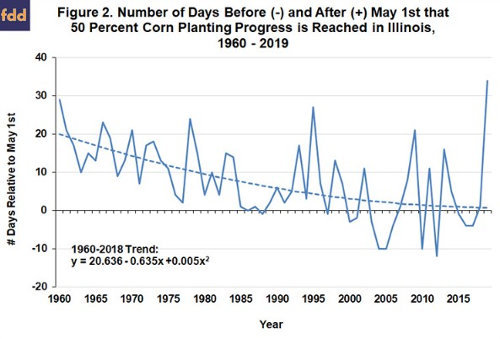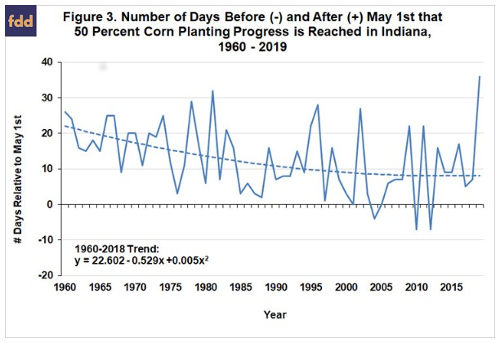By Scott Irwin and Todd Hubbs
Department of Agricultural and Consumer Economics
University of Illinois
The lateness of planting the 2019 U.S. corn crop has been much discussed in recent weeks. We have highlighted this issue and its implications for acreage, yield, and prices in several previous farmdoc daily articles (
April 24, 2019;
May 1, 2019;
May 9, 2013;
May 23, 2019). The measure of late planting used in these articles: i) reflects only corn acres planted fairly late in the planting window; ii) is computed for the entire U.S., and iii) starts in 1980. The purpose of this article is to introduce an alternative measure of the timeliness of planting the 2019 corn crop that can be computed over a longer time period and at the individual state level for Illinois, Indiana, and Iowa. This will provide additional perspective on the magnitude of late planting, especially in the eastern Corn Belt.
Analysis
The measure of late planting for corn used in previous farmdoc daily articles (
April 24, 2019;
May 1, 2019;
May 9, 2013;
May 23, 2019) is based on the percentage of corn planted late in the U.S. over 1980-2019 based on a May 30 cutoff from 1980 through 1985 and a May 20 cutoff date from 1986-2019. The change in cutoff dates in the mid-1980s reflects recommendations for earlier planting that appeared around that time. This specification emphasizes corn acres planted well past the optimum planting window as historically defined by agronomic planting date field trials. Figure 1 presents this measure and it shows that, on average, late planting was 17.7 percent. The level of late planting in 2019 was 50 percent, the highest over the sample period, but only slightly larger than the previous high in 1995. Finally, it is important to note that this measure of late planting, by construction, does not have a significant upward or downward trend.

An alternative measure of planting timeliness was introduced by Irwin, Good, and Tannura (2008). This measure is based on the number of days before or after May 1st that planting progress reaches 50 percent. Since USDA planting progress is only available on a weekly basis, the calendar date of 50 percent completion is estimated by daily interpolation using the two weeks that include 50 percent completion. This measure is an “absolute” measure of timeliness since the midpoint of planting progress is always compared to a fixed calendar date (May 1st). In contrast to the measure presented in Figure 1, this measure will reflect trends towards earlier planting progress over time. Irwin, Good, and Tannura argued that this is a more robust measure of trends in planting progress than other measures. For example, Kucharik (2008) computes the calendar date when 10 percent planting progress is reached. In some years, the first reported data on planting progress is larger than 10 percent, which implies that the 10 percent date is projected without knowledge of actual planting progress in the previous week. Since non-zero planting progress is nearly always reported for the week before and after 50 percent progress is reached, this same problem is highly unlikely to affect the measure proposed by Irwin, Good, and Tannura.
We compute the number of days before or after May 1st that 50 percent corn planting progress is reached in Illinois, Indiana, and Iowa over 1960 through 2019. These three states contained 33 percent of the corn acreage planted in the U.S. during 2018 and should be representative of planting rates over much of the Corn Belt. Figures 2-4 present this measure for each state, respectively, with positive observations on the vertical axis indicating the number of days after May 1st that 50 percent planting progress is reached and negative observations indicating the number of days before May 1st. We estimate the trend lines over 1960-2018 in order to exclude the influence of 2019 observations on the estimated lines.



While Figures 2-4 indicate there has been substantial annual variation in planting progress in each state from year-to-year, a clear trend towards earlier planting is evident. Since 1960, the trend lines indicates that the 50 percent completion date moved from about May 20th to May 1st for Illinois, from about May 20th to May 8th for Indiana, and from about May 18th to May 5th for Iowa. In general, the 50 percent progress date in these three states is now about two to three weeks earlier than in 1960. Two other observations are noteworthy in Figures 2-4. First, the biggest moves toward earlier planting dates occurred in the 1960s and 1970s. Second, as indicated by the non-linear specification of the trends in each state, there has been only modest moves toward earlier planting since the mid-1980s. Little if any decline in the mid-point of planting progress is observed in the last decade in each of the three states. Kucharik (2006, 2008) suggested that a key factor underlying the move to earlier corn planting is a desire to increase the likelihood that higher yielding full season hybrids reach maturity before the first killing frost. Other factors contributing to earlier planting of corn include a shift toward tillage in the fall, conservation tillage, the development of hybrids with a higher tolerance to suboptimal growing conditions, seeds coated with temperature active polymers, increased resistance to disease and pests, and improved planter functioning.
With this background, we can provide additional perspective on the timeliness of corn planting in 2019. Figure 2 shows that Illinois corn planting in 2019 did not reach 50 percent completion until June 4th. This was the latest date for reaching 50 percent in the last 60 years, and by no small margin. The next latest year was 1960, when 50 percent was reached on May 29th, five days earlier than in 2019. This means there was no other year since 1960 when Illinois reached the 50 percent mark of corn planting in June, which is an especially astounding result in light of the fact that the entire planting window for corn in Illinois has been moved back about three weeks since 1960. Put another way, the 50 percent date in 2019 for Illinois was 33.3 days above trend. The next highest year relative to trend was 1995, when the 50 percent date for Illinois was 22.7 days above trend.
The story in Figure 3 for Indiana is largely the same as for Illinois. Corn planting progress in 2019 did not reach 50 percent completion in Indiana until June 6th, again, the latest date in the last 60 years. The 50 percent date in 2019 for Indiana was 27.8 days above trend. The next highest year relative to trend for Indiana was 2002, when the 50 percent date was 18.2 days above trend. Turning to the data for Iowa in Figure 4, the story is different, reflecting better planting conditions. Corn planting progress in 2019 reached 50 percent completion in Iowa on May 14th, about five days later than average in absolute terms. Relative to trend, the 2019 Iowa corn crop does not look quite as timely. The 50 percent date in 2019 for Iowa was 10 days above trend. This is the fifth latest midpoint of corn planting progress for Iowa since 1960.
Implications
It is common knowledge that the 2019 U.S. corn crop has been planted late due an exceptionally wet spring. What may not be as well-appreciated is the historic nature of the lateness, particularly in the eastern Corn Belt. We provide additional perspective on the magnitude of late planting by computing the number of days before or after May 1st that 50 percent corn planting progress is reached in Illinois, Indiana, and Iowa over 1960 through 2019. The analysis shows that Illinois corn planting in 2019 did not reach 50 percent completion until June 4th, the latest date for reaching the midpoint of planting progress in the last 60 years. In fact, 2019 is the only year since 1960 when Illinois reached the 50 percent mark of corn planting in June. This is an especially astounding result in light of the fact that the entire planting window for corn in Illinois has been moved back about three weeks since 1960. Similar results are found for Indiana but less so for Iowa. Corn planting progress in Iowa reached 50 percent completion on May 14th, about 10 days later than trend. Nonetheless, this is still the fifth latest midpoint of corn planting progress relative to trend for Iowa since 1960. The inescapable conclusion is that the lateness of corn planting in the U.S. this year is of truly historic dimensions and what has transpired in the eastern Corn Belt can be labelled in good faith a “black swan” event.